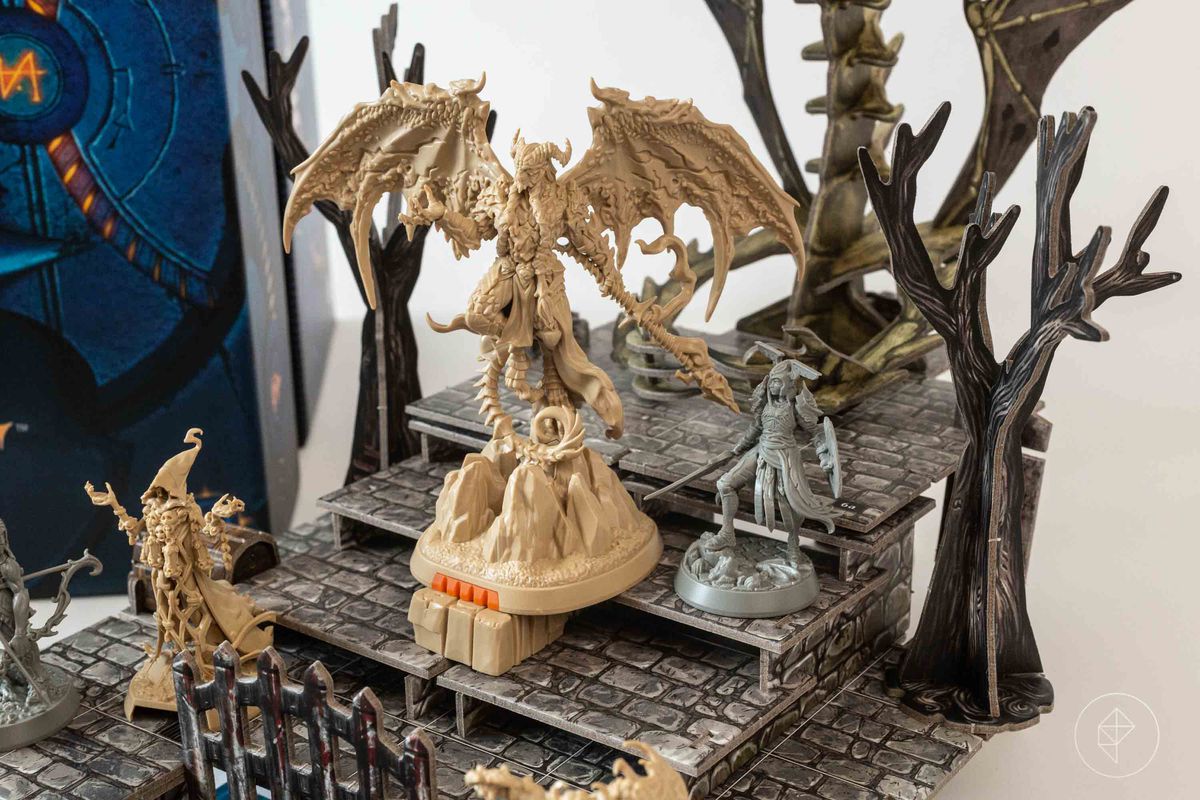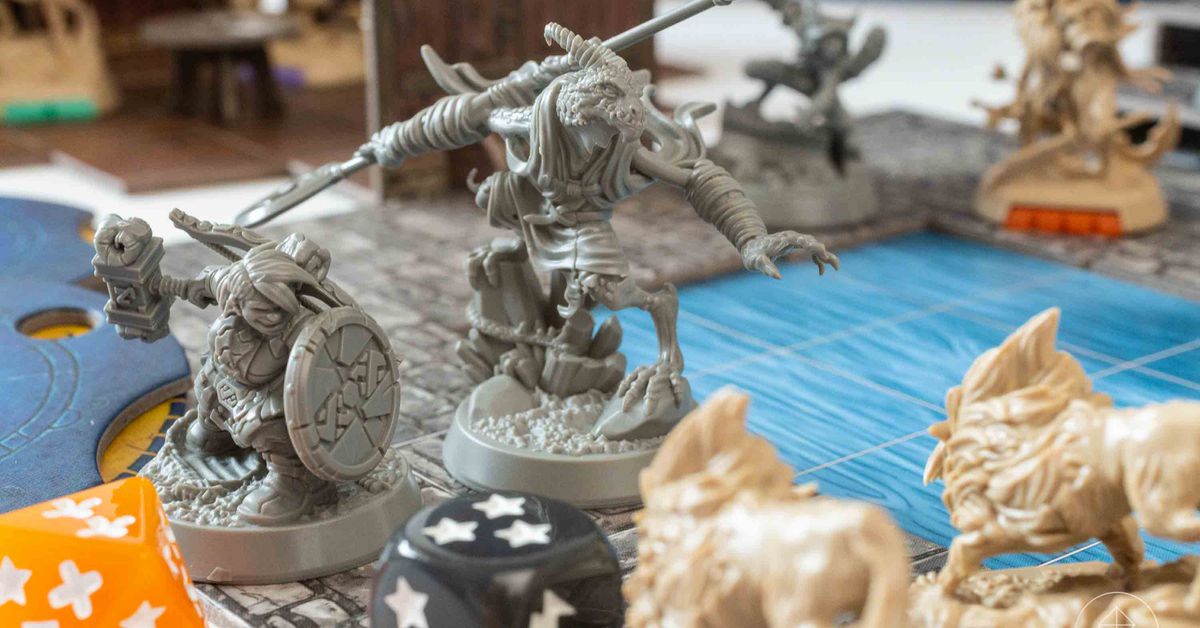Published in 2005, Fantasy Flight Games’ Descent was among the first modern board games that tried to recreate the structure of a traditional role-playing game. One player served as the game master, running the rest of the group through a series of adventures while controlling all the enemies — a bit like Dungeons & Dragons, but with a simplified ruleset. The game’s second edition, Descent: Journeys in the Dark, improved on the experience by providing a greater mission variety while still requiring one player do most of the work. Now Descent: Legends of the Dark - Act 1 has truly fulfilled the series’ promise, providing an experience with all the tactical and narrative depth of an RPG while relying on an app to do the heavy lifting. The result is a rich, seamless experience and one of the very best board games published this year.
Set in the world of Terrinoth, a relatively benign, Tolkien-inspired high fantasy world, the game’s campaign unites six heroes to fight off all manner of threats from ruthless bandits to mad wizards. The required companion app guides players through missions, informing them how to build a 3D map and populate it with treasure, traps, and monsters.
The game is physically imposing. Just unpacking and assembling it requires about an hour of work. You’ll then need a huge amount of table space to lay out the maps, which expand as your characters explore new rooms. The app allows the game to surprise players, forcing them to navigate labyrinths or by having rooms shrink over time as they’re devoured by flame. The app often provides hints as to how they should navigate a situation or deal with a dangerous foe, and paying careful attention to those hints could be the difference between success and failure.
Descent: Legends of the Dark contains a comic book-style visual novel filling in the story behind every mission, and decision trees for each of the characters, which impacts not only the current scenario but also future encounters. These features make Legends of the Dark feel very familiar as a video game, even if I think its designers could have leaned into that medium a bit more. Some voice acting would have been nice, since there’s so much exposition and dialogue that can be hard to share if you don’t have your computer synced to a screen big enough for all the players to see. On the other hand, having players take turns voice acting their characters does add to the feel of being part of a TTRPG.
After the app shows you where to initially place each monster and your party members, it’s up to the players to track their movement on the game board. However, the app will point out who an enemy is attacking, and track random occurrences like special enemy defenses or triggers on a player’s weapon that can do extra damage or apply debuffs. Most challenges, from swinging a weapon to picking a lock on a chest, are handled by rolling dice, with players inputting the results into the app. The result is all the kinetic pleasure of playing a tabletop game without needing to do as much math. It also better enables secret information, like the difficulty of a challenge or what weapon types an enemy is vulnerable to.
The characters all feel very mechanically distinct and there’s a satisfying challenge to coming up with ideal party composition. Most missions require that a specific character come along to complete some part of their personal plot, so you’ll need to learn the nuances of playing each of them.
That complexity mostly lies in a clever system of fatigue management. Do anything special — like add extra success to a roll, or use an ability such as letting an ally move or enfeebling an enemy — and you’ll add some number of fatigue tokens to one of your cards. Some enemies will fatigue you just by hitting you and you might also take fatigue for completing quest objectives like hauling people out of a burning building. If you become too exhausted, you’ll start taking damage.
Players can take an action to flip a card and remove all those fatigue tokens, but every card has different abilities on each side. As a result, players must constantly change tactics even when it might seem like a winning strategy to just keep slamming into an enemy with the weapon already equipped.
The app really shines between missions, when the party heads back to base to rest. The city screen offers a shop with a constantly changing inventory of crafting materials, recipes, and equipment, plus workshops where you can forge your own gear. Potions, armor, and trinkets are represented by cards players keep in the play area and can provide them with powerful effects when used wisely. Trying to scrounge up enough money to get everyone healing potions before embarking on the next mission really felt like playing D&D.

Photo: Charlie Hall/Polygon
In the city and during overland travel you can also play through narrative events that might give more rewards or help flesh out a certain player character. While the plot may rely on broad fantasy tropes, the characters are charmingly individual, like the kind-hearted rogue Chance who loves to steal from bad people and the overly optimistic wizard Syrus who dotes on his phoenix familiar. Additionally, Legends of the Dark isn’t especially linear. The app provides access to multiple quests at once, so you can choose whatever seems most exciting or whatever quest requires the characters you’re in the mood to play.
While the game lets you play with just two characters, it’s best to have a full party of four — even if that means having a player control more than one character. Keeping track of multiple actions ramps up the complexity, but the game just doesn’t scale down properly for smaller groups. Big groups encounter more foes who are also individually tougher, but the real limitation on success is often action economy as your characters need to gather quest items while dealing with timers created by respawning monsters or collapsing terrain. It’s also harder to manage your health and stamina when the bad guys are all ganging up on one or two characters.
Descent: Legends of the Dark - Act 1 boasts 16 main quests, with an average playtime around 50 hours, according to developers. After experiencing roughly one-fifth of that campaign, I can say that the pacing and the density of the narrative feels just right. There’s plenty of room for expansion as well, although how Act 2 will be delivered is still unknown. Like a really good D&D game, I’m expecting this adventure could last years.
Descent: Legends of the Dark was reviewed on Windows PC using a pre-release copy of the physical game and app provided by Fantasy Flight Games. Vox Media has affiliate partnerships. These do not influence editorial content, though Vox Media may earn commissions for products purchased via affiliate links. You can find additional information about Polygon’s ethics policy here.
Polygon – All
Source link
Related Post:
- Descent: Legends of the Dark is the biggest, most ambitious board game of 2024
- Guilty Gear Strive’s Vampire Samurai Says Black Lives Matter
- Cookie Clicker is currently ruining the lives of over 10,000 people on Steam
- Super Monkey Ball Banana Mania has scrapped lives feature
- The Dark Pictures Anthology: House Of Ashes Drops Teaser Trailer Ahead Of Full Reveal Next Week
- Marvel’s Wolverine PS5 Is a Full-Length Game with a Dark Tone
- Skyward Sword HD Review, Our Dream Zelda Games, And More – GI Show
- Achilles Legends Untold Announced by Dark Point Games
- Tales of Arise Fully Animated Opening Movie Is Pretty Hype
- Geoff Keighley Shares Opening Night Live “Hype Trailer” Ahead Of Gamescom 2024
